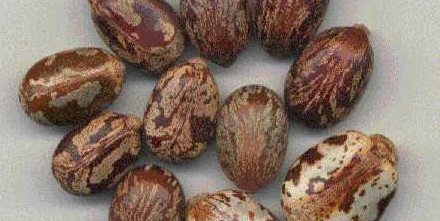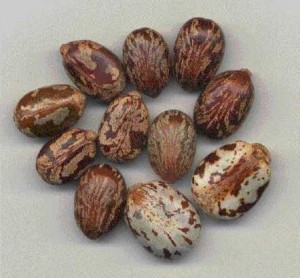
 In honor of Earth Day, I have decided to focus my efforts and write about … Castor Beans. Huh? Well, I have decided to write about a pretty interesting new nylon yarn made from Greenfil, a polymer that comes from Castor Beans. As you may remember from some of my past posts, I love to hear about new discoveries in textile technology and am always excited to share them with you. Upon my initial reading, it wasn’t immediately obvious to me why this yarn is considered “envro-loving” (is that a valid phrase??). Anyhow, I did some homework and upon stumbling on an EcoTextile.com write up, I found out that “The castor plants are from Africa and Asia and are grown on land which cannot be farmed. There is no irrigation of the crops, they are not produced from genetically modified seeds and they are 100% renewable biomass.” Awesome! The yarns are currently made in 3 counts (22, 44, and 78), are round bodied and lustrous, and are being used in undergarments. I heard that the fabrics containing the fiber were shown at Premiere Vision in Paris last autumn. Did anyone happen to catch a glimpse? Do share!
In honor of Earth Day, I have decided to focus my efforts and write about … Castor Beans. Huh? Well, I have decided to write about a pretty interesting new nylon yarn made from Greenfil, a polymer that comes from Castor Beans. As you may remember from some of my past posts, I love to hear about new discoveries in textile technology and am always excited to share them with you. Upon my initial reading, it wasn’t immediately obvious to me why this yarn is considered “envro-loving” (is that a valid phrase??). Anyhow, I did some homework and upon stumbling on an EcoTextile.com write up, I found out that “The castor plants are from Africa and Asia and are grown on land which cannot be farmed. There is no irrigation of the crops, they are not produced from genetically modified seeds and they are 100% renewable biomass.” Awesome! The yarns are currently made in 3 counts (22, 44, and 78), are round bodied and lustrous, and are being used in undergarments. I heard that the fabrics containing the fiber were shown at Premiere Vision in Paris last autumn. Did anyone happen to catch a glimpse? Do share!

Kay Lorraine
Yarn made from castor beans. How amazing is that?!!! If they are so lustrous, I wonder why they are only using them in undergarments? Could it be because they have difficulty in holding dyes?
Please keep us up to date as you find out more about this fascinating new technology.
Warmest aloha,
Kay Lorraine
Honolulu, Hawaii